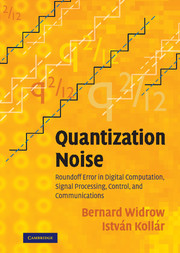 Quantization Noise
Quantization Noise Book contents
- Frontmatter
- Contents
- Preface
- Acknowledgments
- Glossary of Symbols
- Acronyms and Abbreviations
- Part I Background
- 1 Introduction
- 2 Sampling Theory
- 3 Probability Density Functions, Characteristic Functions, and Moments
- Part II Uniform Quantization
- Part III Floating–Point Quantization
- Part IV Quantization in Signal Processing, Feedback Control, and Computations
- Part V Applications of Quantization Noise Theory
- Part VI Quantization of System Parameters
- APPENDICES
- Bibliography
- Index
1 - Introduction
from Part I - Background
Published online by Cambridge University Press: 06 July 2010
- Frontmatter
- Contents
- Preface
- Acknowledgments
- Glossary of Symbols
- Acronyms and Abbreviations
- Part I Background
- 1 Introduction
- 2 Sampling Theory
- 3 Probability Density Functions, Characteristic Functions, and Moments
- Part II Uniform Quantization
- Part III Floating–Point Quantization
- Part IV Quantization in Signal Processing, Feedback Control, and Computations
- Part V Applications of Quantization Noise Theory
- Part VI Quantization of System Parameters
- APPENDICES
- Bibliography
- Index
Summary
DEFINITION OF THE QUANTIZER
Quantization or roundoff occurs whenever physical quantities are represented numerically. The time displayed by a digital watch, the temperature indicated by a digital thermometer, the distances given on a map etc. are all examples of analog values represented by discrete numbers.
The values of measurements may be designated by integers corresponding to their nearest numbers of units. Roundoff errors have values between plus and minus one half unit, and can be made small by choice of the basic unit. It is apparent, however, that the smaller the size of the unit, the larger will be the numbers required to represent the same physical quantities and the greater will be the difficulty and expense in storing and processing these numbers. Often, a balance has to be struck between accuracy and economy. In order to establish such a balance, it is necessary to have a means of evaluating quantitatively the distortion resulting from rough quantization. The analytical difficulty arises from the inherent nonlinearities of the quantization process.
For purposes of analysis, it has been found convenient to define the quantizer as a nonlinear operator having the input–output staircase relation shown in Fig. 1.1(a). The quantizer output x' is a single–valued function of the input x, and the quantizer has an “average gain” of unity. The basic unit of quantization is designated by q.
Information
- Type
- Chapter
- Information
- Quantization NoiseRoundoff Error in Digital Computation, Signal Processing, Control, and Communications, pp. 3 - 12Publisher: Cambridge University PressPrint publication year: 2008
Accessibility standard: Unknown
Why this information is here
This section outlines the accessibility features of this content - including support for screen readers, full keyboard navigation and high-contrast display options. This may not be relevant for you.Accessibility Information
- 1
- Cited by